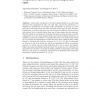Free Online Productivity Tools
i2Speak
i2Symbol
i2OCR
iTex2Img
iWeb2Print
iWeb2Shot
i2Type
iPdf2Split
iPdf2Merge
i2Bopomofo
i2Arabic
i2Style
i2Image
i2PDF
iLatex2Rtf
Sci2ools
89
Voted
FQAS
2006
Springer
2006
Springer
Cooperative Discovery of Interesting Action Rules
Action rules introduced in [12] and extended further to e-action rules [21] have been investigated in [22], [13], [20]. They assume that attributes in a database are divided into two groups: stable and flexible. In general, an action rule can be constructed from two rules extracted earlier from the same database. Furthermore, we assume that these two rules describe two different decision classes and our goal is to re-classify objects from one of these classes into the other one. Flexible attributes are essential in achieving that goal since they provide a tool for making hints to a user what changes within some values of flexible attributes are needed for a given set of objects to re-classify them into a new decision class. There are two aspects of interestingness of rules that have been studied in data mining literature, objective and subjective measures [8], [1], [14], [15], [23]. In this paper we focus on a cost of an action rule which was introduced in [22] as an objective measure....
| Added | 22 Aug 2010 |
| Updated | 22 Aug 2010 |
| Type | Conference |
| Year | 2006 |
| Where | FQAS |
| Authors | Agnieszka Dardzinska, Zbigniew W. Ras |
Comments (0)

